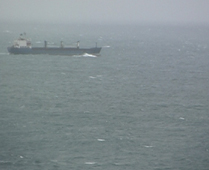Scan Magazine: 2003-12-15
Light Moves: Discussion notes: Imaging the City
Merilyn Fairskye's work can be viewed in the gallery.One of the things that my work has for many years been concerned with is an investigation into the picture plane's extension into space, and the positioning of the spectator within that space. I have explored these concerns in both studio-based and public work using anamorphosis, transparency, and shadow to reconfigure the space between the material surface of the work and the viewer. Recent work more specifically explores how physical boundaries are dissolved - by satellite and telecommunications.
1. Connected 2003
This exhibition of two separate but connected works (shown at Stills Gallery,
Sydney, June 2003, and Araluen Galleries, November 2003) considers how disembodied
and shadowy the experience of being constantly connected can be.
As you enter the exhibition space you initially encounter 9 photographic transparencies that depict life-sized figures, well-dressed business people at the end of the working day, disappearing from view down unidentified city streets (actually Martin Place, Sydney, and the financial district of London). The subjects are shot from behind and hurrying away. Each person appears to be talking on a mobile phone, and they appear disengaged from their environment. I am intrigued by how it?s almost impossible to be fully present where you are any more now that it?s so easy to be virtually anywhere else. I have shot a lot of these images and the subjects are all unknown to me.
Nearby, in a darkened space, as part of the exhibition, a video installation with surround sound explores the shadows and reflections cast on the remote Central Australian township of Alice Springs by the long-term presence of the foreign and highly secretive military base of Pine Gap, one of the largest ground control centres in the world.
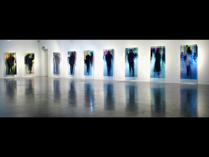
:: Click thumbnail for full size image ::
Nine transparencies, each 175cms X 87.5cms, Type C Prints on Duraclear
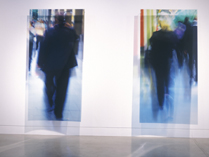 |
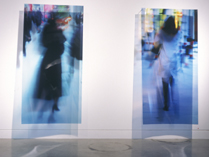 |
:: Click thumbnail for full size image ::
Installation details
2. Tide: 2001
Rialto Square, Manly (in between Wentworth Street and The Corso)
Six polished stainless steel column structures of varying heights are dispersed
in a diagonal line from near Wentworth Street to the beginning of Rialto Lane
where it meets the Square. The overall work could be thought of as a musical
instrument. Each structure houses acoustic sound activated during the day. Fibre
optic lighting is activated at night. Each column?s lighting is a movement
between four monochromatic tones. From one end of the square to the other, the
colour spectrum is played out. The structures are supported off the ground by
a central steel rod. Additional coloured light washes down from inside onto
a white granite surround. The structures appear to float on light.
The height of the columns coincides with high tide levels on six significant dates, from 4000BC to May 28, 2000. There?s an inscription about the date on each column. Once each day, at the time of the lowest tide for that date, the repeated chiming of a single note can be heard in that column. At noon the sounds combine to play an interpretation of a transcription by a European circa 1825 of an Aboriginal song from the Sydney region (David Bartolo and Blair Greenberg worked on the sound).
The polished stainless steel acts as a mirror, reflecting the images of passers by and inverting the surrounding space. Approached from the Corso end, the linished stainless steel has a slight holograpghic effect and the cylinders appear to flatten out. This work was commissioned by Manly City Council.
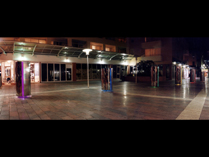 |
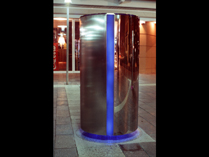 |
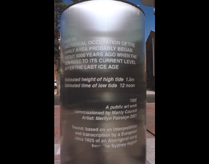 |
:: Click thumbnail for full size image ::
3. Plus+Minus 2000
An event of the Sydney 2000 Olympic Arts Festival, at Stills Gallery Sydney.
This exhibition consisted of three distinct works ? Plus+Minus, a neon
wall piece, Sea and Sky, a two-channel video projection, and four lightboxes,
and Eye Contact, a single-channel DVD projection.
The overall title of the work derives from Piet Mondrian's Plus and Minus series of paintings of sea and sky. The Sea and Sky images were filmed at inner coastal locations around Sydney ? La Perouse and Kurnell, North Head and The Gap. These locations flank the entrance to Botany Bay, the birthplace of Aboriginal dispossession and white Australia, and to Port Jackson, the earliest gateway for new arrivals. I also used images from this series in Material World, in the tunnel lightboxes, and on the bus shelters above ground.
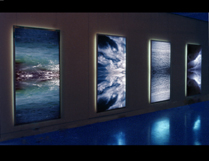
:: Click thumbnail for full size image ::
5. Material World 1999
Devonshire Street Tunnel, Railway Square, Sydney
Crowds of people rush through this space every morning and evening, in a hurry,
on their way to or from work or home, rarely stopping. When I was a student
I use to rush through this tunnel every day, and it always seemed pretty bleak.
When the chance came to do something there I already felt very familiar with
the space, loved the shape of it, and knew almost immediately what I wanted
to do with it. I liked the idea of using light, illusion, and images seen peripherally,
compressing and stretching depending on which direction you approached, to play
with the idea of gateway. That site was the original colonial gateway into Sydney.
Using anamorphic perspective, and digitally stretched and elongated, images
shot around the inner coast, the images appear to move as people rush past.
Every now and then, the hidden image of a face appears and then disappears.
The viewer moves through saturated colours reflected on the ceiling of the tunnel.
These reflections themselves compress and stretch depending on the position
of the viewer, and change in intensity as you move along. This work was commissioned
by Sydney City Council.
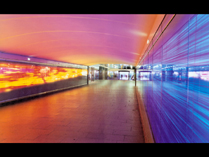 |
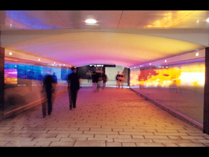 |
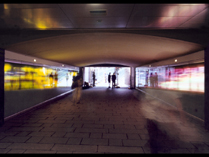 |
:: Click thumbnail for full size image ::
Image 8 Photo credit: Patrick Bingham-Hall
6. Ship 2000
Single-channel video
It?s a grey and stormy day
. a ship crosses The Gap on its way somewhere.
Time goes backwards.
I went out to The Gap to shoot some blue sky. It was a mid Sunday afternoon in winter. By the time I got there from the city a huge storm was building up, the sky was dark grey, the wind was blowing like crazy, making a lot of noise, and I could barely keep the tripod upright. I became mesmerized by a small freighter in the distance trying to make its way out to sea.
Master tape: Betacam SP, Duration: 3 mins 45 secs, colour with stereo sound
:: Click thumbnail to play movie clip ::
All images copyright Merilyn Fairskye. Reproduction not permitted without written permission.
Merilyn Fairskye is a visual artist working with screen-based media, installation, photography and public art. She currently teaches electronic arts and photomedia in the Media Studio at Sydney College of the Arts.
